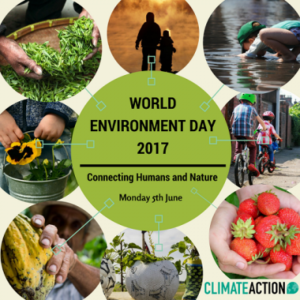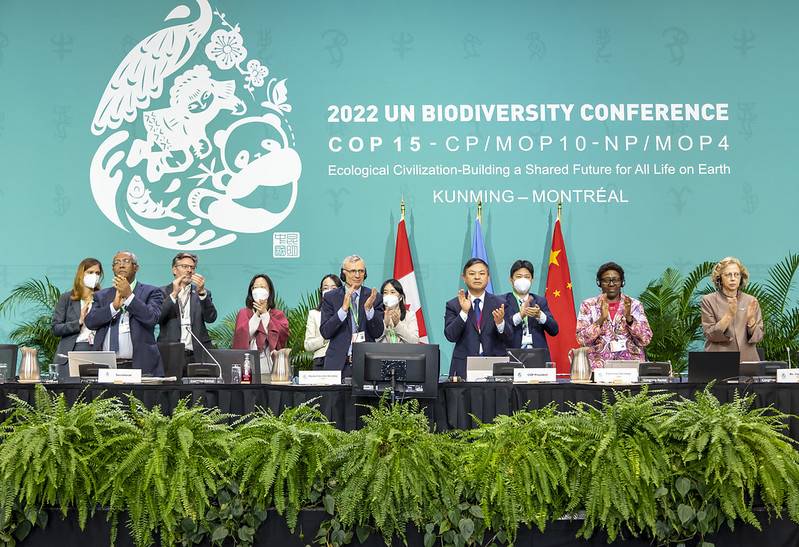
COP15 Global Biodiversity Framework: 196 Countries to Require All Large Business and Financial Institutions to Assess And Disclose Their Risks, Impacts And Dependencies On Nature
What a way to finish 2022! With an unprecedented number of progressive companies attending COP15 and thanks to country negotiators working tirelessly over the past few weeks, a new Kunming-Montreal Global Biodiversity Framework (GBF) has been adopted. We at BSL welcome this historic agreement as it defines our common goal to halt and reverse nature loss by 2030, commits governments to require all large business and financial institutions to assess and disclose their risks, impacts, and dependencies on biodiversity, and promises comprehensive reform of environmentally harmful subsidies. This simply wouldn’t have happened without the effort and teamwork from a huge number of organizations, including many of our partners and leading companies stepping and showing up.
Business leadership and momentum
Business for Nature’s Executive Director, Eva Zabey outlining the outcomes for business at the closing of the High-Level Segment.
In a week of high stakes and high drama – with a tense World Cup thrown in for good measure (congratulations, Argentina) – it was exciting if a little emotional to see a new global agreement on nature adopted by 196 countries in Montreal in the early hours of 19 December. A united voice of progressive businesses had played a critical role in driving momentum and leadership in the run-up to COP15, and many companies showed up on the ground to urge governments to secure a Paris-style agreement on nature. 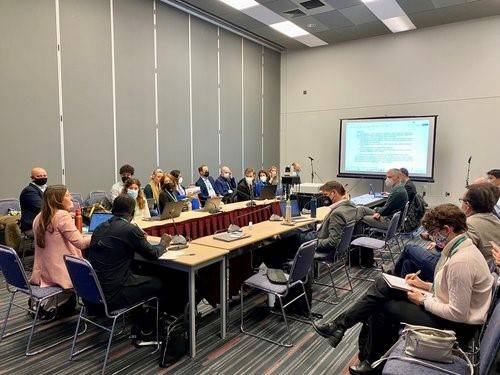
Business Briefing sessions were hosted every morning to provide the latest updates on negotiations during COP15.
Hundreds of corporate leaders contributed to a wide range of business and finance events as either speakers or participants, including the official side events, the Business and Biodiversity Forum, the Business Hub in Place Quebec, the Nature Positive Pavilion, the Global Environment Facility pavilion and in offsite events such as TNFD’s Nature Labs. These rich conversations and discussions gave participants a shared sense of responsibility and, importantly, a feeling of being part of a like-minded business community committed to tackling the collective challenges we face.
We thank the CBD Secretariat and the GBF co-chairs who really lived up to the goal of delivering a Global Biodiversity Framework (GBF) that takes a whole-of-society approach. Observers were welcomed in the negotiation rooms for most sessions – an effective way to engage stakeholders directly. This promoted a genuine and continuous interest in the status of the negotiations.

UNFCC-COP27: Loss-and-damage fund victory undermined by fossil-fuel omissions
How much Sri Lanka stands to benefit from the developments at COP 27 is yet to be seen as much is to be ascertained at COP 28 and the year of secondary negotiations that will precede it. In summary COP 27 established a loss and damage fund, amped up technology based solutions to climate change, and added focus on climate finance but failed to make real progress where emissions were concerned and set more ambitious goals on the 1.5 degree Celsius target and fossil fuels.
The COP27 summit was held with the assembly of countries reaching an agreement on a loss and damage fund. According to Kumudini Vidyalankara, Director of Sri Lanka’s Climate Change Secretariat, a fund was established and a transition committee was appointed to design a mechanism through which the fund would be operationalized.
The appointed committee holds responsibility for whom will be entitled to receive funding, who will have to pay etc. The recommendations are to be presented to COP28, which will be held in United Arab Emirates in 2023. However, Ms. Vidyalankara mentioned experts claiming that it will at least take five years before any money is mobilized. But she also said that vulnerable countries like Sri Lanka will be prioritized.
Yet, the final cover text has been receiving mixed comments as it addresses the results of climate change, but not the cause, which is fossil fuels. Catherine Abreu, Executive Director of Destination Zero has tweeted, that it is unfortunate that UN climate talks have failed to live up to the science, “which is clear that climate action = fossil phase out”.
The final cover text has no indication about oil or gas, and the references to coal and fossil fuel subsidies are filled with qualifiers and loopholes. The treaty, for which is gaining boost, will be functioning as a separate but supporting legal mechanism to end the growth of fossil fuels and manage a transition from coal, oil and gas production. Even the United Nations Framework Convention on Climate Change (UNFCCC), being a critical mechanism for international climate policy, has not facilitated the International Corporation on fossil fuel supply required to manage the global transition.
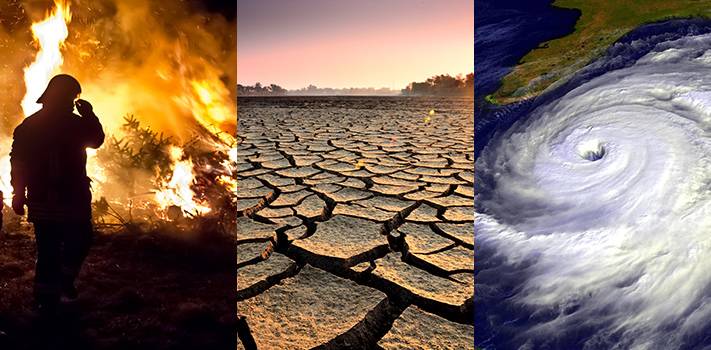
Zero Emissions Day – Zero is the Target
Did you know that September 21st is Zero Emissions Day? The purpose of this day is to give our planet a break from fossil fuels and what they release into the air, at least for one day, every year. This encompasses greenhouse gasses, polluting substances, microparticles, and other things that are harming our planet. The importance of Zero Emissions Day is paramount because it aims to encourage the use of renewable energy sources, as opposed to finite fossil fuels. The primary message associated with the day is “Giving our Earth a day off every year.” This day is devoted to increasing public awareness of potential sources of air pollution and viable solutions for reducing the harm that our everyday emissions may do to the environment. It is an excellent chance to learn about renewable energy sources and natural resources that may be used instead of sources of air pollution.
Biodiversity Sri Lanka celebrated Zero Emissions Day in partnership with its Patron Member, Diesel & Motor Engineering PLC (DIMO). Prof. Ajith de Alwis, Dean of the Faculty of Graduate Studies of the University of Moratuwa focused on emissions from the food and agriculture sector, which is not always considered to be important. He highlighted that one of the primary sources of nitrogen emissions is from fertilizer – emissions from this source being 300 times more dangerous than from carbon dioxide emissions, having detrimental impacts on the environment, including climate change. In order to survive, guaranteeing adequate food security for the people whilst also maintaining the safety of the environment, stringent and responsible management measures must be put in place.
Since all main pollutants have an effect on the climate and the majority of them come from the same sources as greenhouse gases, which cause global warming, air pollution, and climate change are intimately related. Additionally, pollution particles are harmful to human health, which results in acute illnesses like asthma. The right to raise children in a clean and healthy environment will be violated if one lives in an area where harmful chemicals are present in the air. Both children and adults will have a variety of behavioral and mental health concerns as a result. Simply said, it appears that in such a stressful atmosphere, individuals cannot appreciate the serenity and beauty of nature. Enhancing air quality will help our environment, economy, and health.
To lessen air pollution, it would be fantastic if we could lower our carbon footprint and greenhouse gas emissions. Use public transportation whenever available, ride your bike instead of driving, and unplug your electronics when not in use to conserve energy. Companies must embrace environmentally friendly activities including recycling, using renewable energy, and promoting sustainable methods, create and introduce newer, more environmentally friendly goods and services, and raise their positive carbon footprint. As a nation, we can generate electricity using natural resources and renewable energy sources like wind and solar energy.
Let’s celebrate our planet and learn how we can all work together to safeguard nature!

With the CBD COP 15 approaching, Biodiversity Sri Lanka examines what nature-positive means for business?
In December 2022 the world has a unique chance to renew its relationship with nature by adopting a new and ambitious post-2020 Global Biodiversity Framework (GBF) during the 15th conference of the parties to the Convention on Biological Diversity.
Nature underpins prosperity and well-being through the services provided to society and the economy. People rely on nature for services without which their lives would not be possible, such as clean air and water, fertile soil for food, and pest and disease regulation. The interactions between the different elements of nature provide “services” or contributions to society and the economy worth USD $43 trillion. More than half the world’s GDP depends heavily on the functioning of these natural ecosystems. What does nature-positive mean for business?
These “building blocks” guide businesses to act now to halt and reverse nature loss, and credibly contribute to a nature-positive world, with positive impacts outweighing negative impacts on nature from 2030 onwards.
FOR SUPPORT IN THE APPLICATION OF THESE ”BUILDING BLOCKS” – PLEASE CONTACT US
- Assess and Prioritize
Assess realms of nature (biodiversity, freshwater, land, oceans) potentially relevant to operations and the value chain, and prioritize impacts, dependencies and opportunities for regeneration.
Businesses should consider both the living (i.e., biodiversity) and non-living elements that are potentially relevant within all realms of nature (land, freshwater and oceans). Then prioritize them based on an assessment of the material impacts and dependencies on biodiversity and ecosystem services within their direct operations and value chains, and the related risks and opportunities for business, people and the natural world.
- Commit
Set a baseline and commit to ambitious, time-bound, science-informed goals and targets to both halt and reverse the loss of nature.
Building on existing commitments and actions related to nature, businesses should aim to both:
- Halt – Minimize their contributions to negative outcomes for nature and reduce pressure on nature;
- Reverse – Maximize their contributions to positive outcomes in terms of health, abundance, diversity and resilience of species, populations and ecosystems
- Measure & Value
Use validated, interrelated indicators to measure nature outcomes that inform decision-making.
Businesses typically start by measuring and reporting on their business response or actions and resulting change in applicable pressures on nature: land or sea-use change, direct exploitation, climate change, pollution, and invasive species. Businesses can use a framework of indicators to gain a holistic picture of progress on nature goals and targets in order to inform decision-making within and outside businesses
- Act
Businesses should embed nature considerations and aim for nature-positive outcomes across all their spheres of control and influence, prioritizing where there is greatest impact and leverage
Systematically apply the mitigation hierarchy within and beyond corporate operations to reduce pressures and have positive contributions across your value chain.
Halt: Businesses should give priority to avoiding and reducing pressures on nature across all scales of action, particularly for critical ecosystems
Reverse: Businesses should also put in place complementary actions to protect, restore and regenerate nature, including in their wider spheres of influence, including site-based practices as well as product and business-model design.
- Transform
Collaborate to achieve nature-positive outcomes across all spheres of control and influence, including policy, financing and capacity building.
While the potential negative and positive impacts and opportunities will vary across value chains, net-positive is the aspirational direction for all businesses. To help scale up actions and contribute to true systems transformation, businesses should aim to catalyze lasting change and proactively collaborate with key stakeholders at all system levels
- Disclose & Report
Prepare to disclose material nature-related information
Following in the footsteps of climate, businesses should be aware of the growing momentum for nature-related disclosures to help shift finance away from nature-negative outcomes and toward nature-positive outcomes. Business responses to manage those risks and opportunities, including relevant governance structures, strategies, and targets, that will inform investment decisions in the financial system and real economy Thus, disclosure and reporting support the implementation of the other building blocks.

It’s Good News! A potential comeback for the big cat in the Year of the Tiger
Picture credits: World Wildlife Fund
In a tremendous turning point for a species on the brink of extinction, the global tiger population has stabilized and potentially increased, according to the latest International Union for Conservation of Nature’s (IUCN) Red List of Threatened Species Assessment, led by Panthera, the global wild cat conservation organization. New data suggests a potential 40% increase in tiger numbers, from 3,200 in 2015 to 4,500 in 2022, despite extreme threats. Signaling a potential comeback for the big cat in the Year of the Tiger, this represents the first potential climb in the species’ numbers in decades.
Panthera Chief Scientist and Tiger Program Director, Dr. John Goodrich, stated, “While a monumental amount of protection and funding are still needed before proclaiming ‘mission accomplished,’ these numbers signal previously incomprehensible stability in the global tiger population, and even increases in some protected areas. This is nothing short of a watershed moment in the history of the species, made even more remarkable given the overwhelming threats tigers face at every turn.”

Mother tiger (T-19 Krishna) & cubs in Ranthambhore national park, India.
Picture credits: World Wildlife Fund
Goodrich continued, “Protected area population increases in India, Nepal, and Thailand are particularly encouraging as they demonstrate that the recipe for saving tigers can be tailored and replicated across the species’ range. If progress continues as it has in the last decade, I fully expect tigers to be reclassified as ‘Vulnerable’ by the next IUCN Red List Assessment in seven to ten years.”
The IUCN’s latest assessment estimates between 3,726 – 5,578 wild tigers remain in Asia, with an average of 4,500 individuals; 3,140 of the 4,500 are estimated to be adult tigers. Representing 76% of the global tiger population, South Asia’s tigers are gaining numbers, particularly in India and Nepal from where new population estimates are expected any day. In Northeast Asia, numbers are relatively stable in Russia and likely increasing along the border with China. Of all regions, however, Southeast Asia’s tigers are faring the worst, with tigers having been lost from Cambodia, Lao PDR, and Vietnam since the turn of the century.
Panthera scientists cautioned that although new data suggest more tigers exist in the wild than previously estimated, this is partly due to improvements in or a more complete counting of the species, which has made population comparisons over time unreliable. As recently as 15 years ago, scientists were forced to make educated guesses about tiger numbers, but with the invention of and subsequent advances in camera trap technology, genetic testing, data modeling, government collaboration, and more, rangers tracking tigers have vastly improved monitoring efforts.
Inconsistent monitoring methods by tiger range states have produced false positive population increases as well. Previous IUCN assessments, including that led by Panthera, have also incorporated highly conservative population estimates or underestimates, nearly guaranteeing increases in future tiger population estimates. Still, the 2022 IUCN Assessment is now the most reliable and scientifically sound estimate of tigers ever conducted and serves as the first reasonable baseline against which scientists can measure future changes in the global tiger population.

Swapping Debt For Nature
Belize’s barrier reef is a marvel of biodiversity. Stretching 170 miles through the warm waters of the Caribbean and around atolls, cays, and coastal lagoons, the Western Hemisphere’s longest reef is home to some 1,400 species, from endangered hawksbill turtles and manatees to several threatened types of sharks. But climate change and warming oceans, excessive fishing and mangrove felling, and unchecked coastal development all pose risks to the fragile ecosystem.
The reef’s chances of survival received a vital boost last year. On November 5, Belize signed a debt-for-nature swap with The Nature Conservancy (TNC) an environmental organization, which reduced the country’s external debt by a striking 10 percent of GDP. Perhaps more significantly, it greatly improved the prospects for marine protection. Under the agreement, a TNC subsidiary lent funds to Belize to buy back a $553 million “superbond”—the government’s entire stock of external commercial debt, equivalent to 30 percent of GDP—at a discounted price of 55 cents per dollar. In return, Belize agreed to spend about $4 million a year on marine conservation until 2041. It will double its marine-protection parks—spanning coral reefs, mangroves, and the seagrasses where fish spawn—from 15.9 percent of its oceans to 30 percent by 2026.
Can biodiversity-rich Sri Lanka benefit from such debt for nature swaps? With the country facing an unprecedented balance of payments and sovereign debt crisis, threatening prolonged macroeconomic instability and social unrest in the short term – it surely can! The country has been presented with the option to forgo part of its debt in return for its aggressive commitment towards environmental conservation and investments in climate-related projects. Accordingly, the United Nations Development Programme (UNDP) has proposed to the Sri Lankan government to make use of debt-for-nature swaps which would allow a portion of the government’s large debt burden to be forgiven in exchange for the implementation of environmental policies or funding of conservation programmes.
If effectively implemented, debt-for-nature swaps have the potential to provide long-term credit benefits by offering debt relief while increasing investments that could bolster Sri Lanka’s resilience to environmental risks. Given the higher susceptibility of Sri Lanka to natural disasters such as droughts, flash floods, and tropical cyclones, which affect rural household incomes through disruptions caused to agricultural production, business activity, and damages to private property, it is wise for the country to explore this option. This is particularly true when nearly 30 percent of its labour force is engaged in agriculture, which accounts for just 7 percent of the economy.
Crucially, the current crisis risks derailing sustainable development, as the shrinking fiscal space of the government will likely result in limiting the (already low) budgetary allocations for conservation and natural resource management. While the ongoing sovereign debt crisis has led to many ideas around the need for, and opportunity to, introduce innovative financing instruments, there is a risk that without adequate stakeholder understanding of the nuances of such instruments, steps involved, commitments needed, and technical structuring, such efforts may not progress far or could be delayed – simply due to lack of understanding among stakeholders, and there being differences in understanding among types of stakeholders. On the latter, for instance, differences in understanding are already being seen, on the role of, and ways of structuring, such instruments between economists and finance professionals on one hand, and ecologists and environmental experts on the other. Surely this gap must be bridged!
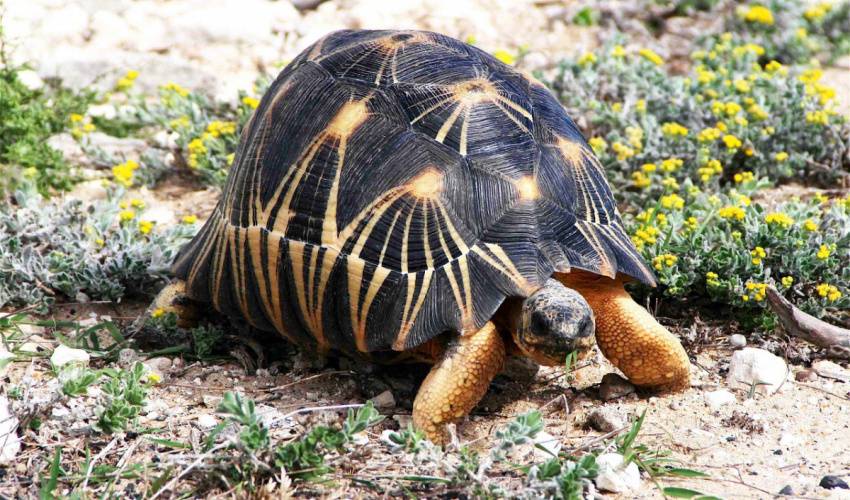
Comprehensive Study of World’s Reptiles: More Than One in Five Reptile Species are Threatened With Extinction
Picture credits – IUCN
(Source IUCN)
Conservation efforts for other animals have likely helped protect many reptile species, according to a new study led by NatureServe, the International Union for Conservation of Nature (IUCN), and Conservation International. The study, published in the journal Nature, presents an analysis of the first comprehensive extinction risk assessment for reptiles on The IUCN Red List of Threatened Species™, which found that at least 21% of all reptile species globally are threatened with extinction.
For the Nature study, a diverse research team, representing 24 countries across six continents, analyzed the conservation needs of 10,196 reptile species in comparison with mammals, birds, and amphibians. Reptiles in the study include turtles, crocodiles, lizards, snakes, and tuatara, the only living member of a lineage that evolved in the Triassic period approximately 200-250 million years ago.
The research revealed that efforts to conserve threatened mammals, birds, and amphibians are more likely than expected to co-benefit many threatened reptiles. Although reptiles are well known to inhabit arid habitats such as deserts and scrubland, most reptile species occur in forested habitats, where they –and other vertebrate groups – suffer from threats such as logging and conversion of forests to agriculture. The study found that 30% of forest-dwelling reptiles are at risk of extinction, compared with 14% of reptiles in arid habitats.
“I was surprised by the degree to which mammals, birds, and amphibians, collectively, can serve as surrogates to reptiles,” said Dr. Bruce Young, co-leader of the study and Chief Zoologist and Senior Conservation Scientist at NatureServe. “This is good news because the extensive efforts to protect better-known animals have also likely contributed to protecting many reptiles. Habitat protection is essential to buffer reptiles, as well as other vertebrates, from threats such as agricultural activities and urban development.”
The study also highlighted what we stand to lose if we fail to protect reptiles. If each of the 1,829 threatened reptiles became extinct, we would lose a combined 15.6 billion years of evolutionary history—including countless adaptations for living in diverse environments.

We recently celebrated the International Day of Women and Girls in Science and International Women’s Day: In this edition we look at Women in Conservation – Easy or not so easy?
Why do we always want to highlight women in different roles? Why cannot we talk about people in conservation in general? As people who want to do something different, to make a change. Born and raised in a region like ours we put things differently, don’t we? Cultural and social norms play a huge part – in challenging women in unconventional job roles. Even though the world is changing in the way men and women are seen in different job roles, we do see them as men and women!
Due to personal commitments and raising a family – most women give up or take a break from their work. Some return, some don’t. There is even a certain age that women need to “settle down”. Often when women stay single, it is frowned upon. Many female graduates end up in desk jobs rather than working in the field. Because as they say – women are born to do documentation and not implementation!
Having both men and women working together is essential for conservation, sharing knowledge, and taking on different roles and responsibilities. But many organizations, authorities, and others exclude women from participating, especially in decision-making roles. Hence the critical need for having both men and women working together for sustainable management of natural resources is missed. There is also the fact that on many occasions, women tend to wait for the opportunity to be given and not take to speaking up – thus likely to be in the background not voicing their opinion. A reason to lose opportunities
Women naturally bond with nature – they are caregivers, bearers of children, nurturers, and a must add-on – getting things done one way or the other. Therefore, women need to be equally and actively involved in processes of conservation as they play a critical role as land managers and resource users. Simply put, effective conservation is not possible without the voices, knowledge, solutions, and contributions of women – especially since they do makeup half of the world’s population. The adaptive capabilities of women make them important resources in addressing climate and environmental challenges.
Being a conservationist or a field researcher is not easy for any person. There is a lot of hard work and commitment put into it. If both males and females equally put in their commitment 100%, then each should get equal opportunities. Unfortunately, this is not the case as at many events – women must make an extra effort to come to a position. This is debatable, but obvious when you see statistics and the roles played by women in conservation in the field and at leading roles – making up less than 30% in research alone.
A woman’s role in conserving biodiversity plays a significant part as they know how to manage resources more sustainably; take our mothers as a very strong example. In terms of influencing – the home is the best place to raise people to be more conscious, share and care about each other more: for women, these are natural instincts and capabilities to build a resilient family unit.
Thus, educating not only girls but also boys in conservation is a must. Educating that there are differences between men and women is all right – it is a must. Educating and creating awareness that both men and women can share the same job role on many occasions, that some can be better at it and to pay respect to each other is also a must. We need to learn that without working together, we cannot fight against wildlife crime, and climate change, eradicate poverty or simply live a healthy sustainable life.
Written by Mega Ganeshan
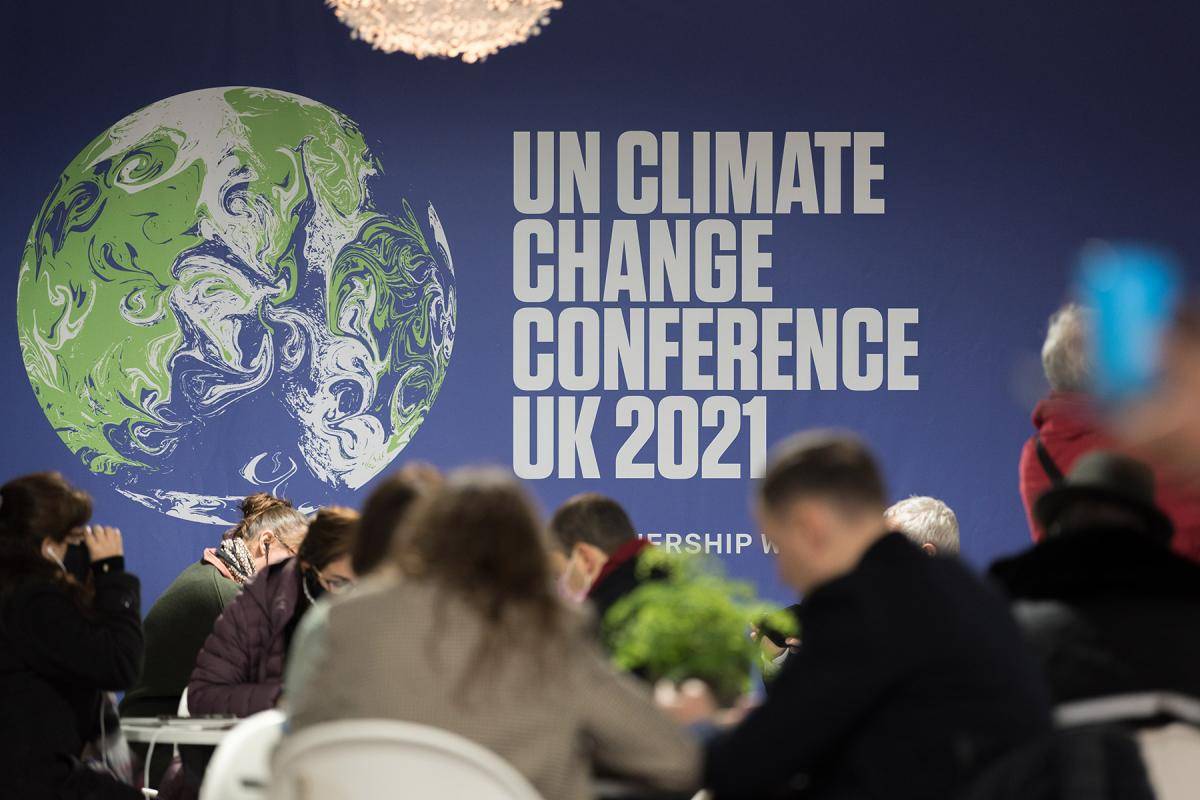
COP 26 – What Next!
By the end of COP26 of the United Nations Framework Convention on Climate Change (UNFCC), held in Glasgow, UK in November 2021, 151 countries had submitted new climate plans, known as nationally determined contributions, or NDCs to slash their carbon emissions by 2030. To keep the goal of limiting temperature rise to 1.5 degrees C within reach, we need to cut global emissions in half by the end of this decade. In contrast, the United Nations calculates that these plans, as they stand, but the world on track for 2.5 degrees C warming by the end of the century. That is better than the 4 degrees C trajectory the world was on before the Paris Agreement was struck, but still extremely dangerous.
But some 2030 targets of major emitters, particularly those from Australia, China, Saudi Arabia, Brazil, and Russia are so weak that they don’t offer credible pathways to achieve their net-zero targets. The Glasgow decision calls on countries to “revisit and strengthen” their 2030 targets by the end of 2022 to align them with the Paris Agreement’s temperature goals. In addition, the pact asks nations to consider further actions to curb potent non-CO2 gases, such as methane, and includes language emphasizing the need to “phase down unabated coal” and “phase-out fossil fuel subsidies.” This marked the first-time negotiators have explicitly referenced shifting away from coal and phasing out fossil fuel subsidies in the COP decision text.
This COP finally recognized the importance of nature for both reducing emissions and building resilience to the impacts of climate change, both in the formal text and also through a raft of initiatives announced on the sidelines. Once we see major emitters’ new climate targets by the end of 2022, we will have a much better idea of whether we will be able to avoid breaching that temperature threshold — and if we do breach it, by how much.
Financial Support for Developing Counties
- In 2009, rich nations committed to mobilizing $100 billion a year by 2020 and through 2025 to support climate efforts in developing countries. Developed countries failed to meet that goal in 2020. The COP26 outcome made it clear that these countries have not fulfilled this goal and stipulated that those countries must report on their progress. The post-2025 climate finance goal is expected to be set by 2024.
- Developed countries also agreed to at least double funding for adaptation by 2025, which would amount to at least $40 billion. This is a significant milestone to address the imbalance between funding for mitigation and adaptation efforts; adaptation finance currently amounts to only a quarter of total climate finance, while need to adapt to the increasing impacts of the climate crisis continues to grow.
- The Adaptation Fund reached unprecedented levels of contributions, with new pledges for $356 million that represent almost three times its mobilization target for 2022.
- COP26 also took steps to help developing countries access good quality finance options. For example, encouraging multilateral institutions to further consider the links between climate vulnerabilities and the need for concessional financial resources for developing countries — such as securing grants rather than loans to avoid increasing their debt burden.
Loss and Damage
COP26 finally put the critical issue of loss and damage squarely on the main stage. Climate change is already causing devastating losses of lives, land, and livelihoods. Some damages are permanent — from communities that are wiped out, to islands disappearing beneath the waves, to water resources that are drying up. Loss and damage are likely to be one of the bigger issues leading up to the COP27 summit in Egypt next year.
Significant outside the negotiations
- a bold commitment from India to reach net-zero emissions by 2070 including ambitious renewable energy targets for 2030)
- 109 countries signed up to the Global Methane Pledge to slash emissions by 30% by 2030
- A pledge by 141 countries to halt and reverse forest loss by 2030 (backed by $18 billion in funding, including $1.7 billion dedicated to support indigenous peoples).
- The UK announced the Glasgow Breakthroughs, a set of global targets meant to dramatically accelerate the innovation and use of clean technologies in five emissions-heavy sectors: power, road transport, steel, hydrogen, and agriculture
Where do we go from here?
- In the year ahead, major emitters need to ramp up their 2030 emissions reduction targets to align with 1.5 degrees C
- more robust approaches are needed to hold all actors accountable for the many commitments made in Glasgow, and much more attention is needed on how to meet the urgent needs of climate-vulnerable countries to help them deal with climate impacts and transition to net-zero economies.
- The Glasgow Climate Pact outlines the key steps to do so. But it is only once this is achieved that we will truly have a shot at reaching the 1.5 degrees C goal and building a safer and more just future for us all.
By the end of this century, Sri Lanka is likely to see an increase of 2-3 °C average temperature rise. There is likely to be significant inundation all around the coast, particularly in places like Negombo and Galle. The country has seen a historical increase, in both the number and intensity of droughts, floods, geographic changes, vector-borne diseases, coastal erosion, tropical storms, lightning, crop failures, landslides, and siltation of reservoirs. All of these are related, at least partially, to temperature and rainfall changes. These events have devastating and adverse impacts on our environment, citizens, infrastructure, businesses, and the national budget. The rising costs of climate change are being and will be, borne by the Sri Lankan public and by corporations that suffer damage. It is also being borne by future generations as the country increases its debt burden on this account. Likely, an inequitable proportion of these losses will be borne by poor and marginalized citizens, living along the banks of canals, rivers, and along the coast or residing in landslide-prone areas. Sri Lanka has little choice but to prepare for and adapt to climate change. Sri Lanka’s greenhouse gas emissions are minuscule in comparison to those of developed nations, India, or China. Climate We cannot stop climate change on our own, but we can prepare for it, safeguard ourselves from it, mitigate its impacts, and where we are the winners of climate change, we can capitalize and make the best of it.
What’s for Business
Over half of the UK’s largest businesses have committed to eliminate their contribution to carbon emissions by 2050. The UK government is calling on the global private sector to follow the UK’s example and join the UN Race to Zero. As of today, 60 of the UK’s FTSE 100 companies have signed up to the United Nation’s Race to Zero campaign – the largest ever global alliance committed to achieving net-zero carbon emissions by 2050 at the latest
Globally, over 5,200 companies of all sizes have now joined the UN Race to Zero, representing sectors like transport, technology, manufacturing, retail, and finance. Nearly half of these are British businesses, with the UK private sector demonstrating international leadership in global efforts to tackle climate change. The Race to Zero acts as a kickstart for companies going green, guiding their actions in the transition to net-zero and positioning businesses at the forefront of the global race to develop new green technology, kick-start new industries, and attract private investment. Businesses both large and small, across all sectors of the global economy, have a crucial role to play in both reducing their environmental impact and developing the green technologies that will set us on the path to net-zero.
Over 2,000 small businesses from across the UK have pledged to reduce their emissions and join the Race to Zero through the Together for Our Planet Business Climate Leaders campaign, launched to help small businesses go green. Acting on climate change will help businesses:
- grow
- seize new opportunities
- create new jobs,
- encourage investment
- adapt against the challenges of a changing planet
- reducing emissions can lower businesses’ running costs, save them money
- attract new customers
- maintain a competitive advantage locally and globally.
The commitments must build on the government’s Net Zero Strategy, which outlines measures to transition to a green and sustainable future.
- to take urgent action and demonstrate their climate leadership by signing-up to Race to Zero and setting out clear pathways to get to net zero.
- make tangible climate commitments that helps chart our path to net zero emissions by 2050.
- grasp the economic opportunities
- Step up to drive the innovation needed
- Net Zero awards – a competition launched to find the best small businesses taking innovative steps to cut greenhouse gas emissions. The Heroes of Net Zero Awards
We must make collective efforts to encourage businesses to go green. We call on all businesses, of all sizes, to pledge to go One Step Greener and sign up to the globally-recognized UN Race to Zero Climate Commitment so, they can protect the planet and their business, and help us start a green business revolution.
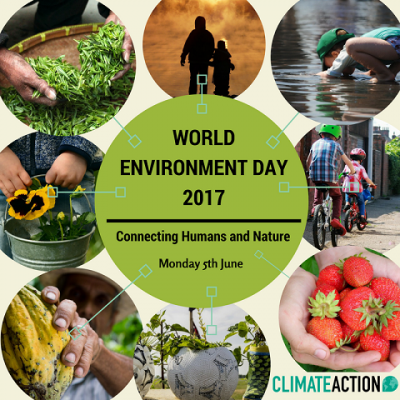
World Environment Day 2017: Connecting People to Nature
World Environment Day – which is observed on 5 June every year across the globe – is the largest annual event for positive environmental action.
World Environment Day was inaugurated in 1972 following the United Nations Conference on the Human Environment in Stockholm, Sweden on 5-16 June – the first international conference on environmental issues.
Since its first celebration on 5 June 1974, millions of people across the world have taken part in thousands of events to raise awareness and generate political momentum around growing concerns such as the depletion of the ozone layer, toxic chemicals, desertification and global warming.
Events range from neighbourhood clean-ups, to action against wildlife crime, to replanting forests.
The Day has developed into a global platform for taking action on urgent environmental issues, driving change in our consumption habits as well as influencing national and international policy.
The host country for this year’s celebration is Canada, succeeding 2016 host Angola.
Canada has chosen the theme “Connecting People to Nature” for 2017, which invites people to enjoy the outdoors and to take forward the call to protect the Earth that we share.
Erik Solheim, Head of UN Environment, said: “It reminds us of what a treasure nature is, and encourages us all to protect and appreciate our environment.”
Countries around the world will host events and introduce initiatives to celebrate the largest annual event for positive environmental action.
This year the citizens of Mumbai, India are taking part in a mass beach clean-up, while Canada is offering free entry to its national parks and marine conservation areas.
To get involved you can join the global album by sharing a photo or video of your favourite place in nature using #WorldEnvironmentDay or #WithNature.
You can also join over 1,000 events taking place across the globe, or even organise your own.
Or why not help build the world’s largest nature database by recording the wonders of biodiversity in your local environment.
World Environment Day has partnered with the iNaturalist global network to record all contributions, which will be shared with scientific data repositories.
Source – 1/06/2017,ClimateAction, See more at – http://www.climateactionprogramme.org/news/world-environment-day-2017-connecting-people-to-nature




